Scissors are a tool we take for granted. They are simple, consisting of two blades with lever action that come together to cut things. Not all scissors are made equal, however. There are different shaped scissors and different sizes; each type tailored to a specific purpose. There are scissors made for cutting fabric, gardening scissors for use with plants, shears for animal wool and fur, scissors made for cutting soft metals, and others for cutting hair. Each pair of scissors is designed specifically for different materials, so it’s important to make sure you have the right type. In this article, we list and explain all the different types of scissors and their uses and and tell you if there are specially-made scissors for left-handers that you can buy.
A lefty might need specially designed scissors in order to use them comfortably. If a pair is designed with a contoured grip, a lefty’s going to find it awkward and a strain on the hand. Besides this, when holding a pair of right-handed scissors in your left hand, the blades themselves will block your line of sight, making cutting things rather difficult.
So, what are the different types of scissors? In this guide, we aim to show you the differences between types and what to expect in terms of available options for left-handed people. You’ll also find some pictures of various types so you can get a clearer idea of them.
Table of Contents
Gardening, Agriculture and Animal Husbandry
Hedge Trimmers
Hedge trimmers are shears with sharp blades and large handles meant for trimming shrubbery and hedges. They look like giant regular scissors except that the handles don’t have loops for for fingers and you hold them with both hands. You would need different sizes depending on the size of the plant being trimmed.
Lefties would best benefit from shears with blades that have double sharp edges.
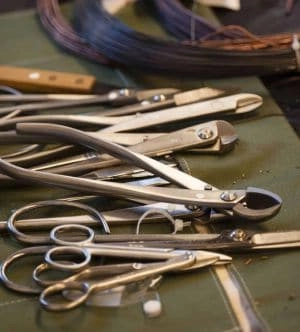
Grass Shears
Grass shears are longer versions of pruning shears that are used for trimming grass on a lawn after using a lawnmower. Grass shears with horizontal blades are used for trimming grass the mower may have missed, and vertical blades help with corners. These shears are sometimes preferred over electric string trimmers because they offer more control. They’re some of the most common gardening tools that come in left-handed versions as well.
Averruncators
Averruncators are a special tool used for trimming the high branches of trees. They are very large with sturdy blades that can cut through wood. They are used by arboriculturists.
Pruning Shears or Secateurs
Pruning shears are the little sibling of averruncators, used in gardens to trim plants and small trees. They are primarily used for shaping plants and trees and cutting away overgrowth. They can’t be used to cut thick branches, however.
Left-handed pruning shears have their blades reversed so that you can easily see your work while shaping a plant or trimming it. The handles are also contoured for the left hand so that there’s less chance of experiencing fatigue and callouses.
Loppers
Loppers are a sturdier version of pruning shears ideal for cutting away slightly thicker branches than pruning shears. They have long handles and short, sharp blades.
Blade Shears
Blade shears are arranged with the hinge close to the opposite end of the sharp tips of the blades. They are most commonly used for shearing animals like sheep, allowing the shearer to cut the wool close to the sheep’s skin. These shears are very commonly used in cold countries like New Zealand because they leave some wool on the animal.
Food and Drugs
Kitchen Scissors
Kitchen scissors are the most common kind of scissors you’d find in your daily life. They have handles that are almost the same size as their blades and are usually made of stainless steel. Some types of kitchen scissors even have things you would find useful in the kitchen built into the handles, like bottle openers and nutcrackers.
As a lefty, you might want to consider buying a pair of left-handed kitchen scissors to make it easier to see what you’re cutting and for general convenience, and there are plenty of options available.
Poultry Shears
Poultry shears are specialized kitchen tools that are designed for cutting poultry meat, like chicken or duck. They have sharp blades, often serrated, made of stronger stainless steel than average kitchen scissors so you can cut through bone with them.
Grooming
Hair Cutting Shears
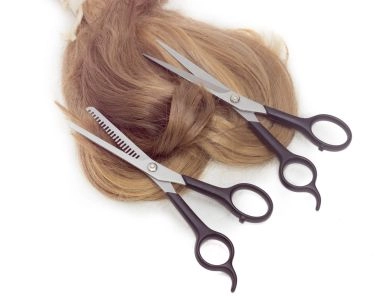
Hair cutting scissors have long, thin blades and small handles. One handle typically has a finger brace on the loop, allowing for better control and precision while cutting hair. Their blades usually measure between 5 and 7 inches in length and are sharper than most scissor blades.
Given the brace on the handle of the scissors and the common problem of hand fatigue, as a lefty, you would want a pair made for left-handed use so that you don’t miss out on the control these scissors offer.
Thinning Shears or Texturizing Shears
Thinning and texturizing shears are shaped like regular scissors, but with teeth like those of a comb cut into one blade. Amongst the different kinds of scissors for cutting hair, these are used for thinning out very thick hair or creating layers without losing length, or to add texture to the hair. They are a common tool in hair salons, and should be used only by someone who knows what they’re doing. There are a few brands that make them for left handers too. You can even find these types of shears in a pet groomer’s toolkit.
Hair Clippers
Manual hair clippers operate on a similar principle to regular scissors, with handles that are pressed together to close the clipper blades, but have a very different shape, and are used to cut a lot of hair at once. They are used to trim the hair very close to the scalp. They are most commonly used in the military, but you are more likely to see automatic, battery powered clippers than manual ones.
In addition, hair clippers are also used for dog grooming.
Nail Scissors
Nail scissors are small, with curved blades that allow you to cut finger and toenails. The curve allows you to shape your nails without creating sharp edges. They are a staple tool in any manicurist’s kit and professional lefty manicurists should get a left handed pair to avoid fatigue and to be able to do a good job.
Nose Scissors
Nose scissors are small like nail scissors, but with thin, blunt blades to avoid hurting the inside of your nose. You can also use them on your ears.
Metalwork
Snips – Tinner, Compound Action Snips, Pipe and Duct Snips
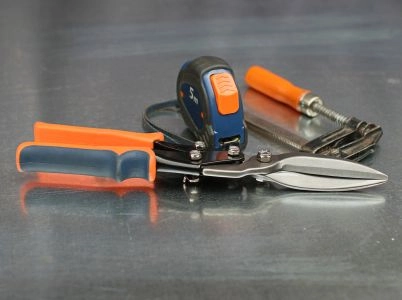
Snips or Electrician shears, are small-bladed scissors designed for cutting through sheet metal. They have very sharp, sturdy blades, and look a bit like pliers. They make it easy to cut straight.
Hydraulic Cutters
Hydraulic cutters are tools powered by hydraulic systems, and are used for prolonged cutting efforts such as at accident scenes. They reduce the amount of physical effort required to cut the material in question.
Throatless Shears
Throatless shears have a single blade attached to a lever which can be pulled to push the blade downward onto the material you wish to cut. They have a flat surface on which you place the metal to be cut. These shears make quick, straight cuts with precision, and are very good for cutting thick sheets of metal or multiple sheets.
Medical

Trauma Shears
Trauma shears are used for cutting clothing in emergency response situations. They have rounded tips to avoid hurting patients.
Most surgical instrument manufacturers have left-handed options for trauma shears available.
Surgical Scissors
Surgical scissors are what they sound like – small, sharp scissors designed for use in surgeries. Most surgical instrument manufacturers make left-handed types of scissors for surgery, so these are widely available for lefty surgeons and medical professionals.
Iris Scissors
Iris scissors are small, originally designed for use in delicate eye surgeries, hence the name. They are commonly used in the medical profession when precise cutting is required, such as for cutting sutures. They come in rounded or sharp bladed versions.
Given the delicate nature of iris scissor usage, it would be better for you to use left-handed iris scissors for easier handling and precision.
Bandage Scissors
Bandage Scissors are used by nurses. Small, with one sharp blade and one blunt, they are used to cut bandages without hurting patients. The sharp blade goes on the bottom and the blunt one on the top.
Due to the asymmetric shape of the blades, it would be important for nurses to use a variant of these scissors specific to their dominant hand, and left-handed variants are available for use.
Sewing and Clothes-making Scissors
As the name implies, these are meant for needlework and dressmaking. There are different types of sewing shears meant for different needleworking tasks.
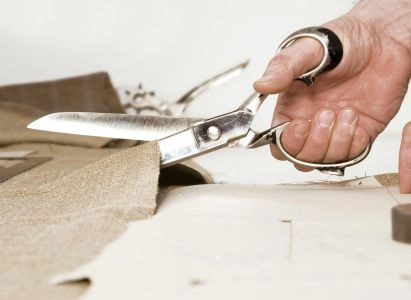
Craft or General Purpose Scissors
These types of scissors for crafts have long blades with sharp tips which can be used for cutting a wide variety of materials that aren’t restricted to crafting supplies. In dressmaking, you would use these scissors for cutting out paper templates of your patterns. Other applications would include kitchen use, arts and crafts, and other general uses.
Left-handed craft scissors help with precision while cutting. They are common in today’s market, and you shouldn’t have trouble locating a pair. You can even get good left handed scissors for kids.
Applique Scissors
Applique scissors are small, with paddle shaped blades. They are meant to keep the fabric away from controlled cuts near seams. They allow for precise cutting without damaging the fabric.
This type of scissors is most commonly used in applique work as the name applies. Lefties would benefit from a pair of left-handed scissors, because the blades will allow you to see your cuts properly. They aren’t as readily available as craft scissors, but options do exist.
Buttonhole scissors have short blades and are chiefly used for opening and replacing buttonholes. They usually have an adjustable screw that allows you to manipulate the size of the buttonhole you wish to make.
Dressmaker’s Shears
These are also called fabric shears. These scissors have long, sharp blades between 7 and 10 inches in length. One blade is rounded to prevent fabric and stitches from getting stuck while cutting. These scissors are designed to hold the fabric steady for precise cuts. They can be used for cutting multiple layers of fabric at a time.
As with crafting scissors, you might want to buy left-handed scissors for cutting fabric because the blades will be arranged so that you can see your cuts.
Embroidery Snips
Embroidery snips are tiny scissors without looped handles, which have very small, sharp blades specifically for cutting threads easily without damaging the fabric. They have very sharp edges that can get into small spaces between sequins and beads easily.
Since embroidery snips are uniform in shape and usually do not have any overlap between the blades, you can just use any scissors you can find.
Pinking Shears
Pinking shears have sawtooth edges cut into their blades to allow cutting fabric in a zig-zag pattern either for decorative edges or to reduce fraying. The serrated edges don’t actually prevent fraying but reduce the length of loose ends, which is particularly useful for preventing woven fabric from unraveling.
A lefty using right-handed pinking shears might experience pain after using them for too long. The problem is that there are no pinking shears made for left-handers. In this case, it’s better to use a left handed rotary cutter that accommodates a pinking blade because these are readily available on the market. In fact, rotary cutters are very efficient for all kinds of fabric cutting applications, like applique work, quilting, and cutting through layers of cloth in one go.
Tailor’s Shears
Tailor’s scissors are shorter than dressmaking scissors, but they serve a similar purpose – to cut heavy fabrics, leather, multiple layers of fabric, and quilting fabric. The blades are thick and precision ground right through to the tip.
A lefty using right-handed tailor’s scissors would face the same disadvantages that they would while using other types of right-handed scissors, but left-handed versions are fairly common.
Summary of Different Types of Scissors
Scissors come in different styles and sizes for different purposes, and in recent times, left-handed variants for each type have become more common. You don’t always need lefty versions for your cutting needs, but they’re nice to have, especially if you use them often. Take a look at how they differ from right-handed scissors. Lefty versions are easy to come by for the most common types of scissors, but you might have difficulty finding left-handed versions for some of the more specialized ones.
We hope our guide will be of use to you in finding the right scissors for a cutting job, and will give you an idea of what to expect when trying to find left handed scissors.
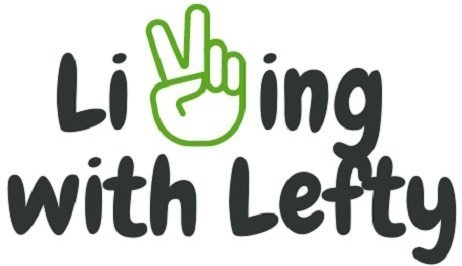
Do you have a recommendation for best general purpose scissors?
I use these multipurpose ones from Maped